G. L. Pease
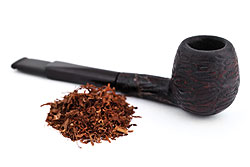 I love the first bowl in a new pipe. The courtship. The anticipation. The excitement. I fill the bowl carefully, taking time to appreciate the workmanship, the grain, the balance, the cut. I test the draw, then strike a match, and slowly tease its fire over the surface of the tobacco, drawing softly, inviting the flame to caress the leaf, bringing it to life in wisps of fragrant smoke. I savour the taste of those first puffs, of the wood as it warms and begins to meld with my chosen tobacco, and contemplate the gradual increase of richness and flavour that will come through the first dozen or so bowls, and even beyond. The ritual engages my senses and my memory in a similar way to that of a fine old wine as I swirl, sniff, and explore it as it develops in the glass.
I love the first bowl in a new pipe. The courtship. The anticipation. The excitement. I fill the bowl carefully, taking time to appreciate the workmanship, the grain, the balance, the cut. I test the draw, then strike a match, and slowly tease its fire over the surface of the tobacco, drawing softly, inviting the flame to caress the leaf, bringing it to life in wisps of fragrant smoke. I savour the taste of those first puffs, of the wood as it warms and begins to meld with my chosen tobacco, and contemplate the gradual increase of richness and flavour that will come through the first dozen or so bowls, and even beyond. The ritual engages my senses and my memory in a similar way to that of a fine old wine as I swirl, sniff, and explore it as it develops in the glass.
The first bowl is a singular experience that can only happen once with each new pipe. It can be sometimes sweet, sometimes bitter, sometimes silky smooth, or other times a bit harsh, but in all cases, providing the pipe was well-crafted from good briar, that first smoke, properly approached, has always seemed special to me. I know I’m not the only one, that many others share my enthusiasm, if not my romanticism over the enticement of a new briar, but, there are others who approach the same experience with more dread than delight. In fact, it seems to me that more smokers pitch their tents in the latter camp than in the former, as though there’s a "conventional wisdom" at play, a socially constructed reality telling us that breaking-in is hard to do; not something to look forward to, but something to approach like weeding the garden or taking out the trash. We have to do it sometimes, even if we don’t really want to.
Where does this particular particle of belief come from? What is it about a new pipe that causes so many pipemen, veteran and tyro alike, to tremble before the task? There must be something behind such a widely held belief to give it at least some historical traction, if not currency. And, why do others amongst our numbers actually look forward to the process? Is it possible that today’s pipes are just better than the ones smoked by our grandfathers? And, if today’s pipes are better, more pleasant vessels on which to embark on those maiden voyages, why does the belief that pipes are painful to break-in persist so tenaciously?
To look for some clues, let’s turn our opera glasses back to a time in history when a high proportion of adult males were pipe smokers, and pipe factories produced millions of pipes every year, not the thousands or tens of thousands produced today. Since I’ve always maintained that the quality of the wood is the most important aspect of a great pipe, the briar seems an appropriate place on which to focus our lenses.
It’s commonly known that briar, in order to deliver the best smoking experience, must begin by being carefully processed by the cutters. Once the burls are harvested, they are cut into smaller blocks which are boiled in clean water for many hours, then slowly dried and made ready for the pipe maker. These blocks are then graded by quality, by size, by coverage and consistency of grain, and by location in the burl. (Interest in straightness of grain is relatively recent. During the early part of the 20th century, in pipe smoking’s glory days, straight-grained pipes happened as happy accidents more so than as planned events. If we examine hundreds of pipes from even the best of the pipe makers of the day, we’ll see a great many pipes of mixed grain, and a very few showing exceptional patterning. Those were usually selected for special grades sold at premium prices. Today, cutters and pipe makers often select their blocks specifically for grain.)
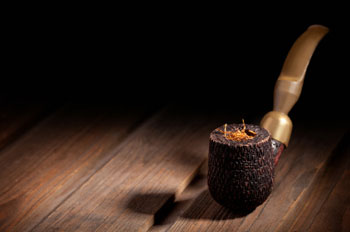 There has always been some disagreement about many things related to briar quality, amongst which are the geographical source of the burls, the age of the heath shrub (Erica arboria) from which the burls are harvested, and therefore the age and size of the burl itself, whether plateau (the outer blocks, with the rough outer surface of the burls intact) or the wood closer to the heart makes for better tasting pipes, how long the wood should be aged before it will make a good pipe, and so on. Indeed, a much more extensive study on this subject could be done, and a little time searching the web on these topics and reading the myriad opinions will reveal a lot of disparate views, but, whilst we’re pulling out our hair trying to make sense of it all, we can also pull out a couple of facts that may be germane.
There has always been some disagreement about many things related to briar quality, amongst which are the geographical source of the burls, the age of the heath shrub (Erica arboria) from which the burls are harvested, and therefore the age and size of the burl itself, whether plateau (the outer blocks, with the rough outer surface of the burls intact) or the wood closer to the heart makes for better tasting pipes, how long the wood should be aged before it will make a good pipe, and so on. Indeed, a much more extensive study on this subject could be done, and a little time searching the web on these topics and reading the myriad opinions will reveal a lot of disparate views, but, whilst we’re pulling out our hair trying to make sense of it all, we can also pull out a couple of facts that may be germane.
First, old burls are bigger than young ones, and if your making millions of pipes, the economy of being able to get the highest yield for the heavy labour costs involved in harvesting those burls would have been an important factor. Though today, burls that are 20-40 years old are thought to be best for both their smoking characteristics and their beauty, the number of blocks these smaller burls provide is considerably fewer than what could be carved out from a much larger 100 year old one. Of course, clever marketing can romance a practicality into something else, and many factories in the twenties and thirties presented the use of this old wood as Good Thing. Whether it really was or not remains questionable.
Then, consider the aging of the blocks. Today’s makers disagree on how long briar should be aged in order to produce a good pipe. Some feel that once it’s dry enough to work without problems, it’s ready to go, whilst others insist that routinely aging their wood for upwards of eight to ten years is the only way to produce a superior smoking pipe. This aging of blocks for years isn’t much of a problem for a cottage industry producing a few tens of thousand pipes per year, but in the age of the industrialized pipe, the storage and management of millions of blocks for many years would present a huge cost, and since the vast majority of pipes being produced were meant to be affordable, utilitarian commodities, sold to the average man, not luxury items accessible only to the elite, this would have been unfeasible. For the high-volume factory producers "back in the day," it would not have been practical to maintain such a large stock for so many years; for economic and practical reasons, the wood would have been used as quickly as possible, with various techniques applied by some of the more exclusive makers, such as oil-curing or kiln-drying, in an attempt to improve the smoking characteristics of their finished product, and further distinguish their wares in a crowded marketplace. (Likely, these would have been the luxury brands, selling lower volumes, but at higher prices. The lesser marques made different claims.)
Finally, what about the wood suppliers, themselves? Today’s briar cutters have learned a thing or two from the past, and from working closely with the premium pipe makers who buy the wood they produce. Since demand for quantity is lower, whilst expectations for quality is arguably higher, burls can be more carefully selected, and can be processed more thoroughly. Tannins, saps and other impurities are driven from the wood through extended boiling, and the resulting blocks are more stringently evaluated for both consistency and flaws. In short, though we can’t know with certainty, it’s likely that today’s briar is actually of a higher overall quality than it was during the high-volume industrial days.
It’s not much of a stretch to conclude that the average pipe being produced today is in some ways better, perhaps even significantly so, than that of yesteryear, and offers a more pleasant early smoking experience than ever before.
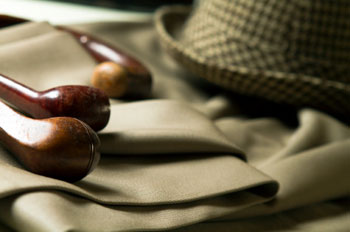 Of course, some veterans will still insist that "they don’t make ‘em like they used to," and this is almost certainly true. Many of those old pipes do have a great deal of appeal, not necessarily because they were fantastic when they were new, but because the pain of break-in has long since been forgotten, and the pipes have seasoned well through their years of being smoked. Much of the work of "aging" the briar in some of those old pipes was done by the smoker as he suffered through the challenges of those first harsh and acrid smokes, and once the corner was turned, once the ordeal by fire had been endured, only the joy of a well broken-in pipe remained. Through some sort of selective amnesia, we often forget the pain of these sorts of rights of passage once we’re through them. Yet the fears persist, at least in the minds of some pipesters. Fears breed expectations, and expectations influence experience. Maybe some pipes are difficult to break in because we expect them to be.
Of course, some veterans will still insist that "they don’t make ‘em like they used to," and this is almost certainly true. Many of those old pipes do have a great deal of appeal, not necessarily because they were fantastic when they were new, but because the pain of break-in has long since been forgotten, and the pipes have seasoned well through their years of being smoked. Much of the work of "aging" the briar in some of those old pipes was done by the smoker as he suffered through the challenges of those first harsh and acrid smokes, and once the corner was turned, once the ordeal by fire had been endured, only the joy of a well broken-in pipe remained. Through some sort of selective amnesia, we often forget the pain of these sorts of rights of passage once we’re through them. Yet the fears persist, at least in the minds of some pipesters. Fears breed expectations, and expectations influence experience. Maybe some pipes are difficult to break in because we expect them to be.
We live in the age of instant information, both a blessing and a curse, and it’s easy to forget that when the pipe’s popularity was peaking, thoughts traveled much more slowly and through much greater effort. When we have to work hard for what we think we know, we tend to cling more tightly to it. Tightly held but slowly propagated, the horror stories of evil, foul tasting pipes that would, eventually and with much pain, transform into faithful and fair companions became embedded in our little corner of culture, becoming part of our overall knowledgescape. I’ve certainly had a few experiences with old, "lesser" pipes that had remained unsmoked for years or decades before finding themselves between my teeth, and I’d be the first to say that some of those old stories may be well founded, but, I think things are different today.
Fewer pipes are being made now, both by factories and within the boutique pipe segment of the industry. With volumes being dramatically lower, smaller burls can be harvested, greater attention can be lavished on the process, and pipe makers can be more selective in the wood they buy, and have the luxury of being able to store and age it longer. The result is that it seems today’s pipes are of an overall higher quality, being much better behaved overall. I’m sure there are still challenging cases with pipes causing more pain than pleasure in those critical early bowls, but my suspicion is that these are the minority. Now, it’s only a matter of time before our collective knowledge catches up and uproots the old meme. Next time you’re faced with a new pipe to break-in, approach it with enthusiasm and joy, and it just might not be so tough, after all.
Your turn.
-glp
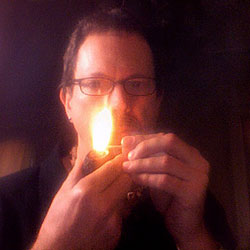
Since 1999, Gregory L. Pease has been the principal alchemist behind the blends of G.L. Pease Artisanal Tobaccos. He’s been a passionate pipeman since his university days, having cut his pipe teeth at the now extinct Drucquer & Sons Tobacconist in Berkeley, California. Greg is also author of The Briar & Leaf Chronicles, a photographer, recovering computer scientist, sometimes chef, and creator of The Epicure’s Asylum. |









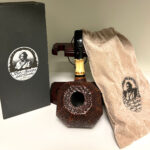
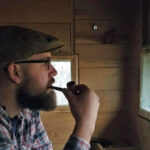
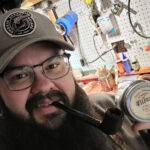



For me the first smoke in a new pipe is probably the most magical as well… so different and so full of expectations :). Your article actually made me want to buy new briar :). Thank you for a great read!
I always look forward to breaking-in a new pipe, especially if the bowl is not pre-coated with carbon. It is a time for developing a relationship with something organic that will respond according to the care I give it, and the choices I make for it. I realize, of course, that this is a fantasy, since in due time my rather arbitrary smoking habits blur whatever distinctions I initially sought to establish.
I’d actually written several paragraphs on the subject of bowl coatings, but decided to move that discussion to a separate, future article. Though I very much prefer a naked bowl, not all coatings are bad. Not surprisingly, those that are have sort of ruined things for the ones that play well with others.
Perhaps we can start to put a stake in the “100 year old briar” myths, and appreciate what we have these days – direct communication between makers and cutters, which is yielding better and better briar. The de-industrialization of the pipe industry, the focus on smaller manufacturers (and higher quality) has given us a new golden age for pipes and pipe enjoyment.
There are many wonderful old pipes out there, but there are many totally awful ones too. Today’s smoker is far more discriminating in terms of performance than most of the pipe users of yore – or rather, the end of the bell curve that is still smoking pipes is more likely the recreational/collector type than the “die with a pipe in my mouth” road-crew boss of days gone by.
I’m not completely sure that breaking in a new pipe is so much a “chore.” For me, it’s the thought of spending money on a pipe that might not really smoke that great. I have a couple of mainstays that are just my daily smokers. They do a perfect job for me; I will never part with them. But when I do get a new pipe, my level of expectation for it is high. Precisely because I have a perfectly good one sitting over yonder and now I’m breaking this one in. It’s like, why would I start putting miles on a new car when I have a perfectly good one that I drive everyday?
Great article and food for thought! I am firmly in your camp Mr. Pease. I love that “first date” with a new pipe, the excitement and anticipation as you say, well I’ve been married for 20 years so if my memory serves me correctly those are the emotions experienced.
I consider myself lucky to have been able to add several lower and mid level new briars to my rotation in the past couple years and every one of them has been dream to smoke from the get go. Some precoated and some bare I’ve not noticed much difference between them. A few have developed a quirkiness but I think that’s more a fault of the fuel I chose to put in those particular pipes. So yes good call to save the bowl coatings for another discussion.
I think you are on to something about the high level of selectivity in briar these days from the harvest all the way to the end user and it sure backs up what I have found starting and cultivating relationships with most of my newly acquired friends. Again thanks for your contributions to PM. Your insight and points of view are always entertaining and thought provoking.
Good article Mr.Pease. I to always look forward to breaking in a new brier. In fact, I have one on it’s way to begin a new relationship with. I agree that the pipes of today are a better product than yesteryear as a whole. Yes, there are some nice old pipes out there and I have a few, but I’m not the one who broke them in. Breaking in a new brier is a special thing for me, and a right of passage for my new pipe as well.
The one minor failure I see in the industry today is not all makers say much about the curing of the brier in their (on-line) description as I’d like, such as oil or kiln-drying. Other than that I think they are superior to years ago.
This is another in a long list of your articles that I’ve enjoyed reading a lot.You have a style of writing that makes for intresting reading.Thanks for the knowledge you share.
Phenomenonology and preconceptions have a lot to answer for in the instant transmission of received wisdoms today. I’m as guilty as anyone but this article made me think.
Of course I love my old Dunhills and Charatans (as well as many London made seconds)but it’s because they are old – either bought as estates or because I’ve had them from new for 30-40 years – and I’m now challenged to have to recall what were actually a few difficult bitter experiences back then. My recent new English pipes from Ashton, Upshall, Ferndown and Askwith have all been good from the first bowl.
It’s good to be honest with one’s self!
Edit to “phenomenology” – it’s like trying to spell banana (don’t know when to stop!).
As always, thank you for the very enjoyable and insightful read.
I have found that if the inside of a new briar is stained, it will give a very bitter edge to the fine tobacco. Last time, at the advice of someone much grayer than me, I removed as much stain from the inside of the bowl as possible with a good bourbon and paper towel (carefully!! so as to not effect the finish on the top of the bowl) and let it sit overnight. Then results were much improved!
Happy Smoke Trails,
FP Stew
I remember in the old days of Smokers Haven in Columbus, when it was on Gay Street, that Joe Zieve who sold those incredible GBD’s, among others, such as Charatans, etc, used to break in pipes for favorite customers. It was not unusual to see him smoking a pipe on which he put a rubber sleeve for just such a purpose. At the time, I used to ask myself if I would ever be so important for that service to be available to me. This goal was like a similar one at that time, and that was making a salary that equaled your age…which meant you were rich. Of course my first French-made GBD purchased from SH was a $15 poker. You can guess my age.
One of the first pipes I bought was from the smokeshop where I worked- a very cheap Mexican Dublin meant to be sold in a basket. It’s very lightweight, dull black and rustic in a very gentle way. To this day I wonder if it’s actually briar. The draw is also a little too tight due to the narrow tunnel in the lucite stem.
There were times I nearly threw this pipe away. It was very much a two-step forward, one-step back type of affair. It was always the last pipe I reached for.
Today it’s my Tuesday pipe in my suggested, 7 day rotation. So it’s not smoked each Tuesday, but often is. I prefer it for Latakia blends but it’s not exclusive. I like to smoke this one slowly on the couch when I’m reading. With it’s narrow bore, it doesn’t permit hard-puffing!
It’s nothing special to look at either- it’s almost as if it’s made from black lava. But the thing smokes as fine as anything now.
It took long enough.
With my employee discount I bought this about 17 years ago for $10.
Very interesting story. When I get a new pipe I look forward to the first bowl with high anticipation. That first bowl may color my opinion forever of a pipe.
great as always, breaking in a low priced Chacom at moment and it taste pretty good to me.
Many thanks Greg for another very fine article. I agree on all points raised. Recently I had the good fortune to acquire a cased set of six vintage, unsmoked Comoy’s Blue Ribands. The six pipes sat with me for quite a while before I decided that, yes, indeed, I was going to smoke them. The pipes all had heavily pre-carbonized bowls. I also noticed that the carbonized material coated the inside of the draft hole and mortise as well. The initial smokes were not that smooth. This necessitated the removal of all this material using Everclear grain alcohol, cleaners, tissues and swabs. All the way down to the bare naked blond wood. Subsequent smokes have been unparalleled! Spectacular, even. I’ve decided to smoke three, and maintain the virginity of the other three for posterity. The former three are now each on their seventh bowls, and its all smooth sailing and fair winds.